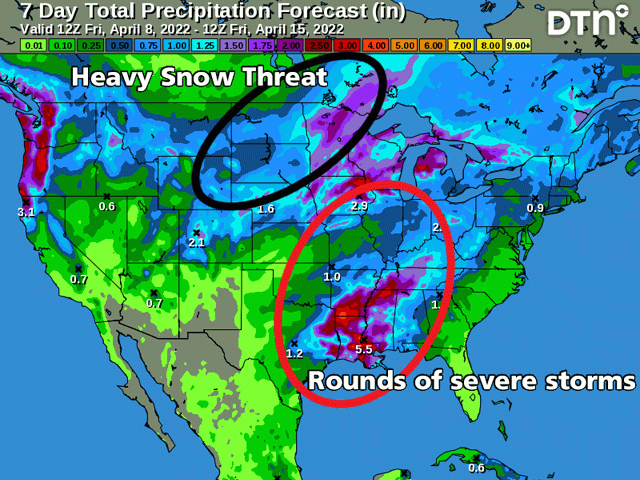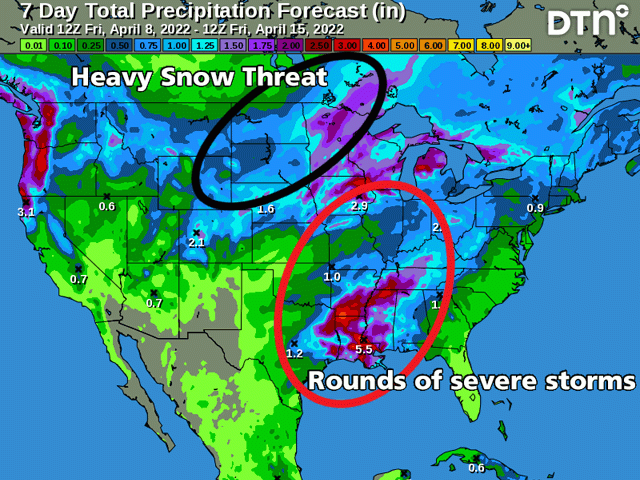Ag Weather Forum
Severe Storms in the South and Heavy Snow in the Northern Plains Highlight Active Week for US
It is springtime in the Northern Hemisphere and we should not be surprised that the weather is active. Whenever we transition from the cold season to warm season or vice-versa, the rapid change in sun angle and length of day gives rise to strong differences between cold to the north and hot to the south.
Strong temperature gradients lead to strong storm systems that bring a host of weather concerns to the regions they hit.
Next week will follow the last several in that regard where we have seen widespread strong storm systems bringing snow, heavy rain, severe weather and strong winds. This one will be only slightly different. The southern United States has had at least one severe weather event each week since mid-March. Next week, we are likely to see several.
Heavy snow has been reluctant to affect widespread areas with recent storms. Next week, we are anticipating a widespread heavy snowfall event. Strong winds will be similar to previous systems, as will the periods of heavy rain. And temperatures behind the system are forecast to fall significantly, but a bit more than other systems this spring. Overall, this coming week is going to be a doozie.
P[L1] D[0x0] M[300x250] OOP[F] ADUNIT[] T[]
A strong trough that is off the coast of British Columbia on April 8 will dive into the western U.S. during the weekend and deepen. Meanwhile, a trough in the east that brought us our last system will move out and be replaced by a ridge. The result between the two will mean a preferred storm track from the Southwest to the Northeast. The trough will send several pieces of energy along the track before itself moves eastward late next week and weekend.
Each impulse will bring risks of severe weather. The Storm Prediction Center has outlined April 11-13 as having a risk of severe weather across the eastern Plains into the Mississippi Valley. And the only reason they have not extended that threat to April 14 or 15, or eastward, is because of uncertainty on the overall evolution of the storm systems next week. It is rather rare for the Storm Prediction Center to outline multiple days of severe weather hazards beyond its Day 3 outlook. But the significant setup for the week warrants its mention. Each of those events also comes with the risk of heavy rainfall, limiting fieldwork and planting for those eager to get out into their fields.
One of these strong impulses is likely to lead to the development of a strong storm system in the April 12-14 time frame. The track is still up for debate in the models, but is most likely to track from Colorado to Lake Superior. With significantly cold air on the north side of the system and moist air being wrapped into the center, that should produce a rather thick band of moderate to heavy snow across the Northern Plains and Upper Midwest. It may be too early to talk about specific amounts, but the setup favors risks of more than 12 inches of snow in a wide area.
According to DTN Long Range Team Lead Nathan Hamblin, it is rather impressive on just how all the ingredients seem to be there for a big snowfall event. He said Northwest Minnesota through North Dakota and probably through the Black Hills into Montana and Wyoming have the greatest risk of seeing more than 12 inches of snow. "We are seeing 30-40% chances on the ensembles in a seven-day forecast and that's significant. I think it's almost a guarantee somebody gets a foot of snow out of this. The B word (blizzard) will be around too, almost guaranteed. It's just a matter of where."
That brings up the risk of winds. As with most deep storm systems in springtime, winds will be howling yet again, possibly exceeding 50 miles per hour. Likely to coincide with the heavy snowfall, winds should lead to blizzard conditions where that heavy snow sets up. Winds will be strong elsewhere too, leading to more dust blowing and wildfire risks in the Southern Plains.
The only areas not to see a significant precipitation threat is unfortunately the southwestern Plains where drought has been persistently building and worsening throughout the winter. Only minor improvements were made temporarily a couple of weeks ago with a system that was fortunate enough to bring some precipitation to the region. Winter wheat conditions are historically poor in this area and the continued lack of meaningful precipitation along with strong winds and occasional heat are taking a toll on the crop.
Speaking of temperatures, that is yet another matter to discuss. Ahead of the storm system from the Southern Plains to the East Coast, the ridge of high pressure should allow temperatures to soar well-above normal. But in the West, temperatures will fall some 10 to 20 degrees below normal. The contrast in temperatures sets up the large storm system for next week. The cold will spread eastward behind the system next week and the temperature change will be dramatic. Across the north, where the heavy snow is expected to occur, the drop will be the most pronounced, slowing the melting of the snow for the following several days. Those low temperatures spreading eastward could lead to some late frosty conditions for wheat in the Plains and Midwest, though it is difficult to say at this time if the cold will be enough to cause damage to a crop that is not as far advanced.
Still, the cooling conditions that persist days after the event will continue to slow down the rising soil temperatures. And combined with the heavy precipitation potential, will limit fieldwork and early planting toward the end of the month for areas along and east of the Mississippi River. Windows were expected to be short in the Eastern Corn Belt and Delta this year due to the soggy soils that have been in place since the winter, and it appears to be coming true as we advance through April as well.
To find more regional weather conditions and your local forecast from DTN, head over to https://www.dtnpf.com/…
John Baranick can be reached at john.baranick@dtn.com
(c) Copyright 2022 DTN, LLC. All rights reserved.






Comments
To comment, please Log In or Join our Community .